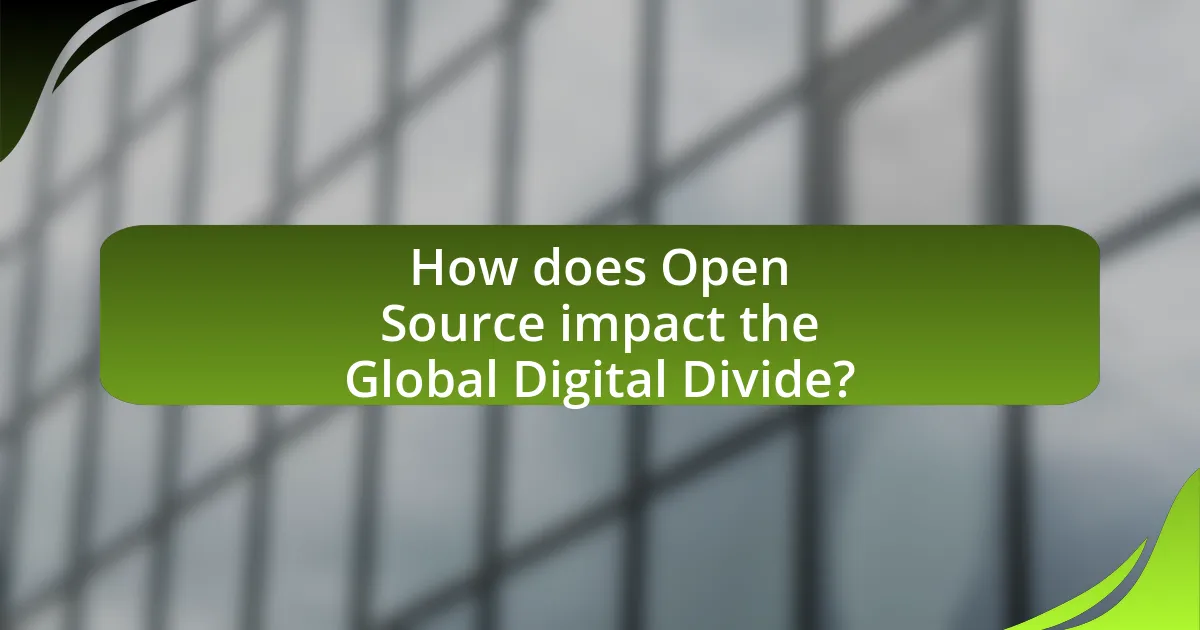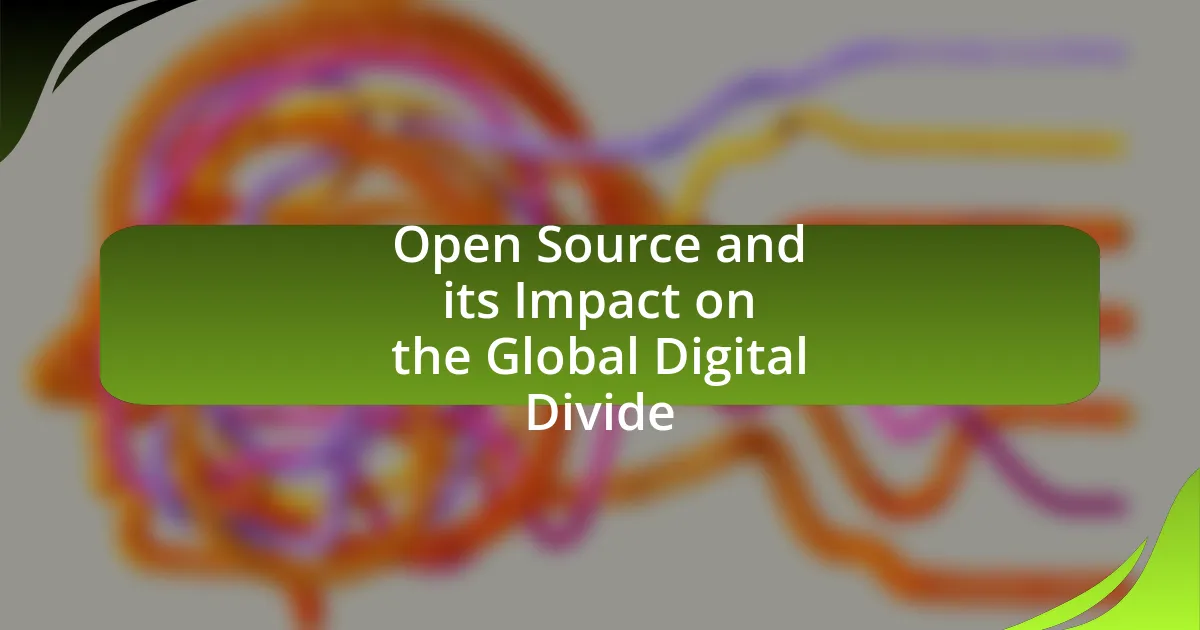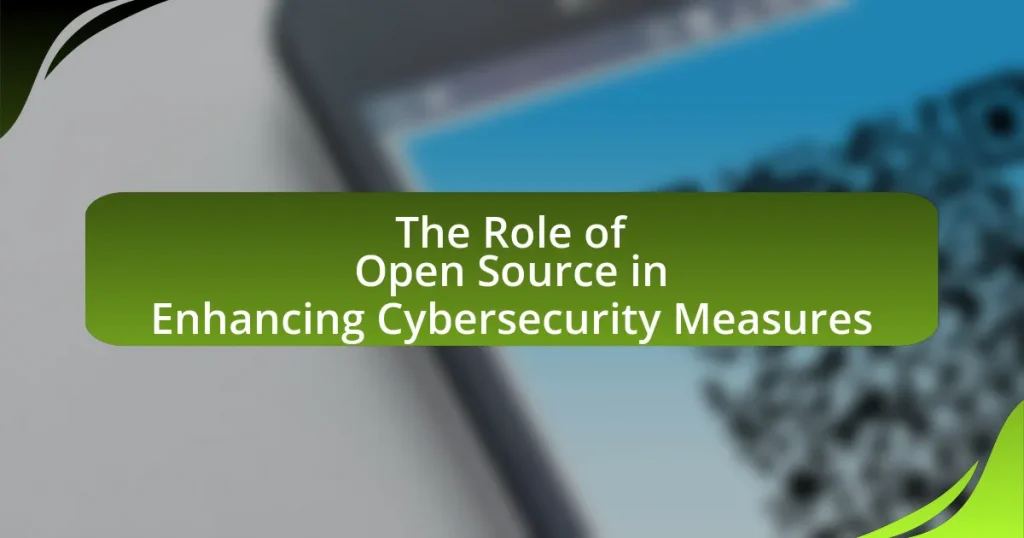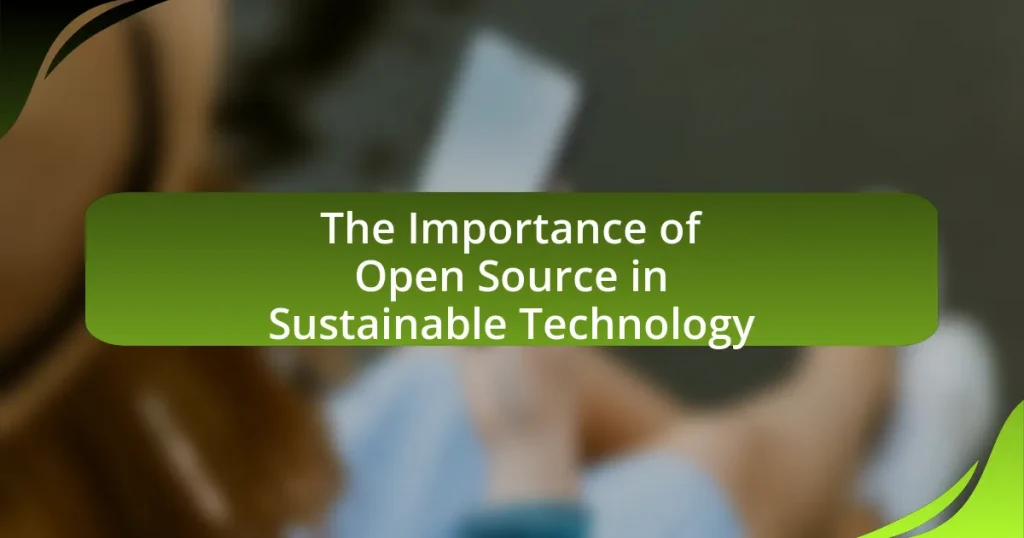Open source refers to software with publicly available source code that can be used, modified, and distributed by anyone, fostering collaboration and innovation in technology. This article explores the role of open source in addressing the global digital divide by promoting accessibility, reducing costs, and enabling rapid development cycles. It examines the differences between open source and proprietary software, highlights key characteristics and historical developments of the open source movement, and discusses its significance in education, skill development, and local innovation. Additionally, the article addresses the challenges and barriers to technology access in developing regions, while outlining strategies for leveraging open source initiatives to enhance digital inclusion and sustainability.

What is Open Source and its Role in Technology?
Open source refers to software whose source code is made available to the public for use, modification, and distribution. This model fosters collaboration and innovation, allowing developers to improve software collectively. Open source plays a crucial role in technology by promoting accessibility, reducing costs, and enabling rapid development cycles. For instance, the Linux operating system, which is open source, powers a significant portion of the internet and is used in various applications, from servers to smartphones. The open source model has led to the creation of a vast ecosystem of tools and platforms, such as Apache and Mozilla Firefox, which have democratized technology access and contributed to bridging the global digital divide.
How does Open Source software differ from proprietary software?
Open Source software differs from proprietary software primarily in its licensing and accessibility. Open Source software allows users to view, modify, and distribute the source code, promoting collaboration and transparency, while proprietary software restricts access to the source code and typically requires users to purchase licenses for use. For example, the GNU General Public License (GPL) governs many Open Source projects, ensuring that the software remains free and open for all users, whereas proprietary software like Microsoft Windows is sold under strict licensing agreements that limit user rights. This fundamental difference influences the development, distribution, and usage of software, impacting innovation and accessibility in the digital landscape.
What are the key characteristics of Open Source software?
Open Source software is characterized by its accessibility, collaborative development, and freedom to modify. Accessibility allows users to view and download the source code, fostering transparency. Collaborative development involves contributions from a community of developers, enhancing innovation and quality. The freedom to modify enables users to adapt the software to their needs, promoting customization and flexibility. These characteristics are foundational to the Open Source movement, which has led to widespread adoption in various sectors, including education and technology, thereby influencing the global digital divide by providing affordable alternatives to proprietary software.
Why is transparency important in Open Source development?
Transparency is crucial in Open Source development because it fosters trust and collaboration among developers and users. When the source code is openly available, anyone can inspect, modify, and improve it, which leads to higher quality software and rapid innovation. For instance, studies have shown that projects with transparent practices attract more contributors and receive more frequent updates, enhancing their security and functionality. Additionally, transparency allows for accountability, as developers can be held responsible for their code, which is essential in maintaining the integrity of software used globally.
What are the historical developments of Open Source?
The historical developments of Open Source began in the 1950s with the sharing of software among researchers and universities, which laid the groundwork for collaborative programming. In 1983, Richard Stallman launched the GNU Project, aiming to create a free Unix-like operating system, and introduced the concept of copyleft, allowing software to be freely modified and distributed. The term “Open Source” was officially coined in 1998 by Bruce Perens and Eric S. Raymond, promoting software that is both free and open for modification. The release of the Linux kernel by Linus Torvalds in 1991 further accelerated the movement, leading to widespread adoption and the establishment of various Open Source licenses. By the early 2000s, major corporations began to embrace Open Source, recognizing its potential for innovation and cost savings, which significantly influenced the software industry and contributed to the democratization of technology.
How did the Open Source movement begin?
The Open Source movement began in the late 20th century as a response to the restrictive licensing of software, particularly highlighted by the release of the GNU General Public License (GPL) by Richard Stallman in 1989. Stallman aimed to promote software freedom, allowing users to run, modify, and share software without restrictions. This initiative laid the groundwork for collaborative software development, leading to the establishment of the Open Source Initiative in 1998, which further formalized the principles of open source software. The movement gained traction as developers and organizations recognized the benefits of transparency, collaboration, and community-driven innovation, ultimately influencing the software industry and contributing to the democratization of technology.
What milestones have shaped the Open Source landscape?
The Open Source landscape has been shaped by several key milestones, including the release of the GNU General Public License (GPL) in 1989, which established a legal framework for software freedom. This was followed by the creation of the Open Source Initiative (OSI) in 1998, which formalized the definition of open source software and promoted its adoption. The launch of major projects like Linux in 1991 and Apache in 1995 further propelled the movement, demonstrating the viability of collaborative software development. Additionally, the rise of platforms like GitHub in 2008 facilitated community engagement and project collaboration, significantly expanding the reach and impact of open source. These milestones collectively contributed to the growth and acceptance of open source as a fundamental aspect of the software industry.
What is the significance of Open Source in addressing the digital divide?
Open Source plays a crucial role in addressing the digital divide by providing accessible and affordable technology solutions to underserved communities. By allowing anyone to use, modify, and distribute software, Open Source reduces barriers to entry for individuals and organizations that may lack the financial resources to purchase proprietary software. For instance, the use of Open Source operating systems like Linux has enabled schools in low-income areas to implement computer labs without incurring high licensing fees, thus enhancing digital literacy and access to information. Furthermore, studies have shown that Open Source initiatives can foster local innovation and collaboration, empowering communities to develop tailored solutions that meet their specific needs, thereby bridging the gap in digital access and skills.
How does Open Source contribute to accessibility in technology?
Open Source contributes to accessibility in technology by providing free and modifiable software that can be tailored to meet diverse user needs. This adaptability allows developers and organizations to create solutions that address specific accessibility challenges, such as visual impairments or mobility issues. For instance, projects like the Linux operating system and the Mozilla Firefox browser have incorporated accessibility features based on community feedback, enhancing usability for individuals with disabilities. Furthermore, the collaborative nature of Open Source fosters innovation, enabling a wide range of contributors to improve accessibility tools, which ultimately leads to a more inclusive digital environment.
What role does Open Source play in education and skill development?
Open Source plays a crucial role in education and skill development by providing free access to software, resources, and collaborative learning environments. This accessibility enables learners to acquire technical skills without financial barriers, fostering innovation and creativity. For instance, platforms like GitHub and educational resources such as MOOCs (Massive Open Online Courses) utilize Open Source tools, allowing students to engage in real-world projects and gain practical experience. According to a study by the Open Source Initiative, 70% of educators reported that Open Source software enhances student engagement and learning outcomes, demonstrating its effectiveness in skill development.

How does Open Source impact the Global Digital Divide?
Open source software significantly reduces the global digital divide by providing free access to technology and resources. This accessibility enables individuals and communities in low-income regions to utilize and develop software without the financial barriers associated with proprietary solutions. For instance, the use of open source platforms like Linux and Apache has empowered many developing countries to build their own technological infrastructures, fostering local innovation and reducing dependency on expensive commercial software. According to a report by the World Bank, open source initiatives have been instrumental in increasing digital literacy and skills in underserved populations, thereby promoting economic growth and social inclusion.
What are the barriers to technology access in developing regions?
Barriers to technology access in developing regions include inadequate infrastructure, high costs, and limited digital literacy. Inadequate infrastructure, such as unreliable electricity and poor internet connectivity, hampers the ability to utilize technology effectively. High costs associated with devices and internet services further restrict access, as many individuals cannot afford these expenses. Additionally, limited digital literacy prevents effective use of available technology, as many people lack the skills necessary to navigate digital tools. According to the International Telecommunication Union, as of 2021, approximately 2.9 billion people remain unconnected globally, with a significant concentration in developing regions, highlighting the extent of these barriers.
How does cost affect technology adoption in low-income areas?
Cost significantly hinders technology adoption in low-income areas by limiting access to necessary resources. High prices for devices, software, and internet connectivity create barriers that prevent individuals and communities from utilizing technology effectively. For instance, a study by the International Telecommunication Union found that in many developing regions, the cost of mobile data can consume a substantial portion of monthly income, making it unaffordable for low-income households. This financial strain leads to lower rates of technology adoption, which in turn exacerbates the digital divide, as those in low-income areas remain disconnected from essential digital services and opportunities.
What infrastructure challenges hinder digital access?
Infrastructure challenges that hinder digital access include inadequate broadband connectivity, lack of reliable electricity, and insufficient technological infrastructure. In many rural and underserved urban areas, broadband access is limited, with approximately 3.7 billion people globally lacking internet connectivity as of 2021, according to the International Telecommunication Union. Additionally, unreliable electricity supply affects the ability to maintain digital devices and services, particularly in developing regions. Furthermore, the absence of necessary technological infrastructure, such as data centers and network equipment, exacerbates the digital divide, making it difficult for communities to access and utilize digital resources effectively.
How can Open Source initiatives help bridge the digital divide?
Open Source initiatives can help bridge the digital divide by providing free access to software and resources, enabling individuals and communities to develop digital skills and access technology. These initiatives lower barriers to entry for technology adoption, particularly in underserved regions where proprietary software costs can be prohibitive. For example, the use of Linux and other open-source platforms has empowered educational institutions in developing countries to implement technology in classrooms without incurring high licensing fees. Additionally, collaborative development models foster community engagement and local innovation, allowing users to adapt tools to their specific needs, which is crucial for addressing local challenges.
What successful Open Source projects have targeted underserved communities?
Successful Open Source projects that have targeted underserved communities include the Ushahidi platform, which enables users to crowdsource information during crises, and the OpenStreetMap initiative, which provides free geographic data to improve navigation and mapping in areas lacking infrastructure. Ushahidi has been utilized in various humanitarian efforts, such as during the 2010 Haiti earthquake, demonstrating its effectiveness in real-time data collection and dissemination. OpenStreetMap has empowered local communities by allowing them to create and edit maps, significantly enhancing access to geographic information in regions that are often overlooked by commercial mapping services. These projects illustrate the potential of Open Source solutions to address specific needs within underserved populations.
How do community-driven Open Source projects foster local innovation?
Community-driven Open Source projects foster local innovation by enabling collaboration and knowledge sharing among local developers and users. These projects create an inclusive environment where individuals can contribute their skills and ideas, leading to the development of solutions tailored to local needs. For instance, the OpenStreetMap project allows communities to map their own areas, resulting in localized data that can drive urban planning and disaster response. Additionally, studies have shown that regions with active Open Source communities experience increased technological literacy and entrepreneurship, as participants gain hands-on experience and access to resources that empower them to innovate.
What are the potential challenges of Open Source in reducing the digital divide?
Open Source faces several challenges in reducing the digital divide, primarily including accessibility, technical expertise, and sustainability. Accessibility issues arise when users lack the necessary hardware or internet connectivity to utilize Open Source software effectively. Technical expertise is another barrier, as many individuals in underserved communities may not possess the skills required to install, configure, or maintain Open Source solutions. Furthermore, sustainability challenges exist, as ongoing support and development for Open Source projects can be inconsistent, leading to potential obsolescence or lack of updates. These factors collectively hinder the effectiveness of Open Source initiatives in bridging the digital divide.
What are the risks of relying on Open Source solutions in developing regions?
Relying on Open Source solutions in developing regions poses several risks, including security vulnerabilities, lack of support, and potential for inadequate local expertise. Security vulnerabilities arise because open-source software can be scrutinized by malicious actors, leading to exploitation if not regularly updated or patched. The lack of support is significant, as many open-source projects do not offer formal customer service, leaving users without assistance when issues arise. Additionally, developing regions may face a shortage of local expertise to implement, customize, and maintain these solutions effectively, which can hinder their successful adoption and use. These risks can ultimately impede technological advancement and exacerbate the digital divide in these areas.
How can sustainability be ensured for Open Source projects?
Sustainability for Open Source projects can be ensured through community engagement, consistent funding, and clear governance structures. Engaging a diverse community fosters collaboration and innovation, which are essential for long-term project viability. Consistent funding, whether through donations, sponsorships, or grants, provides the necessary resources for ongoing development and maintenance. Clear governance structures help in decision-making processes, ensuring that the project remains aligned with its goals and can adapt to changing needs. Research indicates that projects with active community involvement and financial backing are more likely to thrive; for instance, the Open Source Initiative reports that projects with diverse contributors see a 50% increase in sustainability metrics compared to those with limited participation.

What are the future prospects of Open Source in the context of the digital divide?
The future prospects of Open Source in the context of the digital divide are promising, as Open Source software can enhance accessibility and affordability of technology for underserved communities. Open Source initiatives, such as the development of low-cost educational tools and platforms, empower individuals in low-income regions by providing free access to software that can be customized to meet local needs. For instance, projects like Sugar Labs and Moodle have successfully delivered educational resources to schools in developing countries, demonstrating the potential of Open Source to bridge the gap in digital access. Furthermore, the collaborative nature of Open Source fosters community engagement and skill development, which can lead to sustainable technological growth in areas previously hindered by economic constraints.
How can governments and organizations support Open Source initiatives?
Governments and organizations can support Open Source initiatives by providing funding, resources, and policy frameworks that encourage collaboration and development. For instance, governments can allocate budgetary resources to Open Source projects, as seen in countries like France, which has invested in Open Source software for public administration to enhance transparency and reduce costs. Additionally, organizations can contribute by offering technical support, hosting events, and creating platforms for developers to collaborate, similar to how the Mozilla Foundation supports Open Source through community engagement and educational programs. These actions not only foster innovation but also help bridge the digital divide by making technology more accessible and affordable.
What policies can promote Open Source adoption in education and public services?
Policies that can promote Open Source adoption in education and public services include mandating the use of Open Source software in government procurement processes and providing funding for Open Source projects in educational institutions. Mandating Open Source in procurement ensures that public funds support software that is transparent and modifiable, fostering innovation and reducing vendor lock-in. For instance, the European Union has implemented policies encouraging member states to adopt Open Source solutions, which has led to increased collaboration and cost savings. Additionally, funding initiatives for educational institutions to develop and implement Open Source software can enhance digital literacy and technical skills among students, as evidenced by programs like the U.S. Department of Education’s support for Open Educational Resources, which promotes the use of freely accessible educational materials.
How can partnerships enhance the impact of Open Source on the digital divide?
Partnerships can enhance the impact of Open Source on the digital divide by facilitating resource sharing, knowledge transfer, and collaborative development. For instance, organizations like the Mozilla Foundation and various educational institutions have partnered to create open educational resources, which help bridge the gap in digital literacy and access. These collaborations enable the pooling of expertise and funding, leading to the development of tailored solutions that address specific community needs, such as localized software and training programs. Furthermore, partnerships with governments and NGOs can amplify outreach efforts, ensuring that Open Source tools reach underserved populations, thereby increasing their digital inclusion.
What best practices can be adopted for effective Open Source implementation?
Effective Open Source implementation can be achieved by adopting best practices such as establishing clear governance structures, fostering community engagement, and ensuring comprehensive documentation. Clear governance structures provide a framework for decision-making and conflict resolution, which is essential for maintaining project integrity and direction. Community engagement encourages contributions from diverse participants, enhancing innovation and sustainability; for instance, projects like Linux and Apache thrive due to active community involvement. Comprehensive documentation ensures that users and contributors can easily understand and utilize the software, which is critical for onboarding new users and maintaining project momentum. These practices collectively enhance the effectiveness of Open Source initiatives, contributing to their success and impact on bridging the global digital divide.
How can communities be engaged in Open Source projects?
Communities can be engaged in Open Source projects by fostering collaboration through inclusive platforms, providing educational resources, and encouraging contributions. Open Source projects often utilize platforms like GitHub, where community members can collaborate on code, report issues, and suggest features, thus creating an environment of shared ownership. Educational initiatives, such as workshops and online courses, can equip community members with the necessary skills to contribute effectively. Furthermore, organizations like Mozilla and the Apache Software Foundation actively promote community engagement by offering mentorship programs and clear contribution guidelines, which have been shown to increase participation rates and enhance project sustainability.
What strategies can ensure the longevity of Open Source initiatives?
To ensure the longevity of Open Source initiatives, fostering a strong community and sustainable funding models are essential strategies. A vibrant community encourages collaboration, knowledge sharing, and continuous improvement, which are critical for the project’s evolution. For instance, successful projects like Linux and Apache have thrived due to active community engagement and contributions from diverse developers. Additionally, establishing sustainable funding through donations, sponsorships, or grants can provide the necessary resources for ongoing development and maintenance. Research by the Open Source Initiative indicates that projects with clear funding strategies are more likely to survive long-term, as they can support infrastructure and incentivize contributors.
What are the key takeaways for leveraging Open Source to combat the digital divide?
Leveraging Open Source to combat the digital divide involves promoting accessibility, fostering collaboration, and enhancing education. Open Source software is typically free and modifiable, which allows individuals and communities with limited resources to access technology without financial barriers. For instance, the use of Open Source platforms like Linux has enabled low-cost computing solutions in underserved regions, facilitating digital inclusion. Additionally, Open Source encourages collaboration among developers and users, leading to the creation of localized solutions that address specific community needs. Educational initiatives that utilize Open Source tools can empower individuals with the skills necessary to navigate and contribute to the digital landscape, further bridging the gap. These strategies collectively demonstrate how Open Source can effectively reduce disparities in digital access and literacy.



